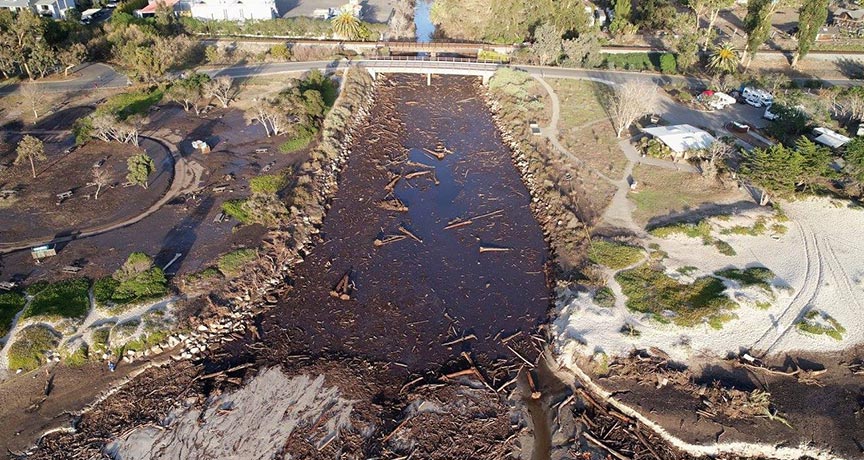
When Carpinteria Creek flooded after a January 2018 storm, it undermined the treatment plant’s retaining wall. (photo by Casey Balch)
It’s the new “abnormal” as Governor Jerry Brown calls it. Bigger and more intense fires have killed more people in California and destroyed more property than ever before.
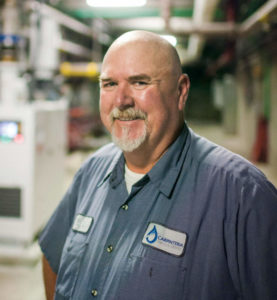
Mark Bennett
Even as the fires are put out, water professionals know there’s a new threat. Floods. Fires and floods happen so often throughout California’s history, some regions have names for the destructive mudflows. In SoCal, one person calls them “rock porridge.”
Mark Bennett is the Operations Manager for the Carpinteria Sanitary District. He’s seen dozens of fires and floods over the five decades he’s lived in the Carpinteria and Montecito region. He’s also a Board Member for our TriCounties Section.
Just 11 months ago, in January 2018, Carpinteria and Montecito saw catastrophic mudflows after fires burned away all the vegetation on surrounding hillsides. After that mud flow swept through Montecito 21 people were killed, 65 homes destroyed and 460 homes were damaged.
We caught up with Mark before Thanksgiving to gather advice on how water and sewer districts can prepare for the upcoming mud flows.
Thinking back to the January mudflows, what were the emergency plans you had in place when they struck?
Well, I’ve been through the “500 year flood” and “100 year floods” a couple of times now. Having been through these events, the District has a strong understanding of our vulnerabilities within the collection system and at the treatment plant.
Preparing for a major rain event is an “all hands on deck” endeavor for us. Collections personnel go to all the known low lying areas and ensure inflow dishes are installed and look for new potential rain flow/drainage issues. Operations personnel stage pumps and generators at lift stations. In hindsight, we should have moved a couple more trucks out of our plant, because the entryway to the plant was flooded (after the January storm).
This contingency plan is in our SSMP (Sanitary Sewer Management Plan). If somebody like myself or one of the supervisors is not on site, the operators and collection system operators have access to it on paper or can access it digitally via District issued Ipads. From within the SSMP, personnel can reference detailed SOPs.
These preparations are not done solely before a storm event. All the backup equipment at each lift station is routinely ran and evaluated for readiness.
Before a forecasted storm arrives, we break our staff into shifts instead of a regular day shift. This gives us the upper hand in operational awareness and the ability to react to any potential problems.
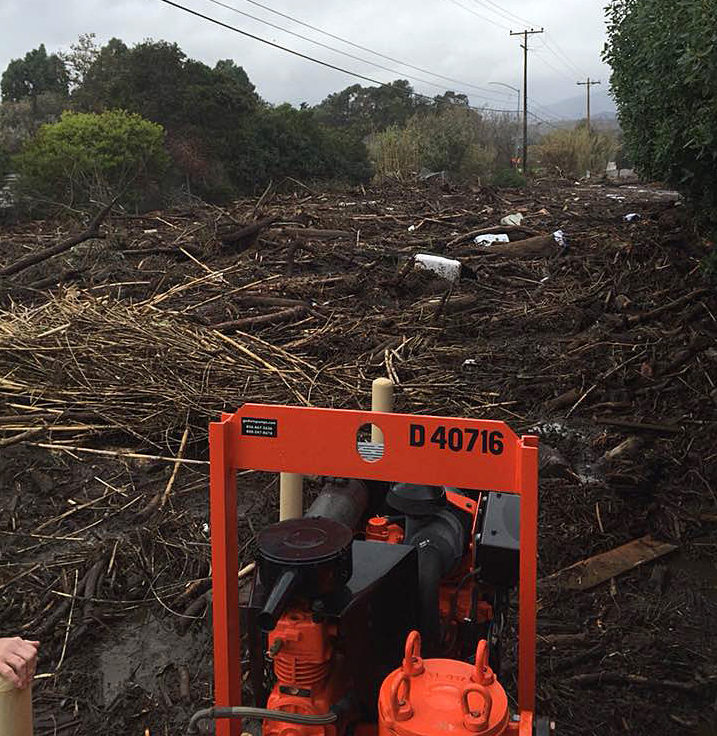
Emergency bypass pump was positioned before the storm. (Mark Bennett)
What did you need to adapt to on the fly?
One of the things we didn’t foresee was the City of Carpinteria being isolated for an extended amount of time. We were cut off to the north going to Santa Barbara for 3 weeks, and we were also cut off to the south to Ventura for about a week.
We’ve had issues with the road being closed before, but nothing to this extent.
This isn’t something we had planned for. It is something we have discussed in terms of fuel supply, chemical delivery, food/water and short term housing for our personnel.
In addition to the supply chain being compromised our staffing levels were severely impacted as well.
More than half of the Operations staff reside in Santa Barbara and they couldn’t get to the treatment plant. Although we were understaffed for a period of time, our staff who live in Carpinteria stepped up to the plate to keep things going.
What lessons did you take away from the January mudflows?
The thing that is still a vulnerability is fuel. You can store fuel for a one, two or three days depending on the size of tanks you’re allowed to install, but if you’re isolated you can only go until your fuel runs out. Likewise for chemical deliveries such as hypochlorite and bisulfate, it depends on where you are in your delivery cycle will determine how long you can run.
There’s another priority when you’re isolated, not just staffing, but feeding your staff. The food from our local grocery stores disappeared almost immediately.
One of the things we did in preparation for upcoming evacuations and further mudslides, because like I said, it’s going to happen again, is having some kind of emergency food supply.
We’ve also prepared to have some staff stay here at the treatment plant. First, they make sure their families are safe, and they make plans to be here. We have staff here to make sure that our infrastructure is covered.
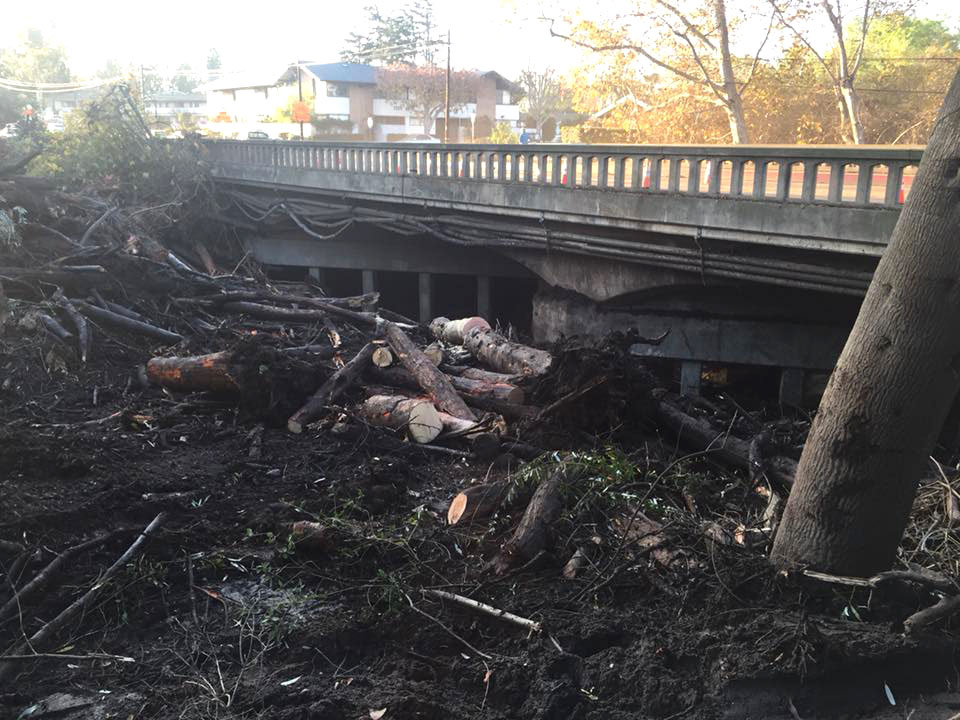
Bridge near the Carpinteria Treatment Plant. By Mark Bennett
What was the biggest impact on the District?
The surge of water and debris that came down the Carpinteria Creek undermined and destabilized the concrete rock wall embankment that borders the southeast side of the treatment plant. We’re in the process of installing a temporary repair that consists of shoring up the embankment by driving “H” piles and linking them with trench plate and backfilling with concrete and rip rap.
Another impact on the District was flood waters that surcharged the City owned storm drain system. The road to our administration office, the treatment plant, a preschool, and employee housing for CA State Park employees was impassable. After we determined that our assets were all in good shape, we assisted the City in clean-up efforts and many others around town. We also went to go help Montecito.
Was this a known weak point, or did this surprise you?
The impact to the flood wall was definitely a surprise. Carpinteria Creek borders the treatment plant and does not have a debris basin upstream and it is not concrete lined unlike the majority of the other creeks in Carpinteria. Another contributing factor to this is that at the time of the Thomas Fire and the storm, Caltrans was in the process of building a new bridge over Carpinteria Creek.
The storm dropped too much water too fast and caused a massive debris flow to come down the creek and “hung up” at this new bridge and built enormous head pressure before breaking free. The velocity of the debris flow moved so fast and with such force that boulders could be heard rolling down the creek from 5 blocks away. After the flood waters in the creek receded, the creek bed was scoured to a depth not previously seen and the flood wall was noticeably impacted by this event.
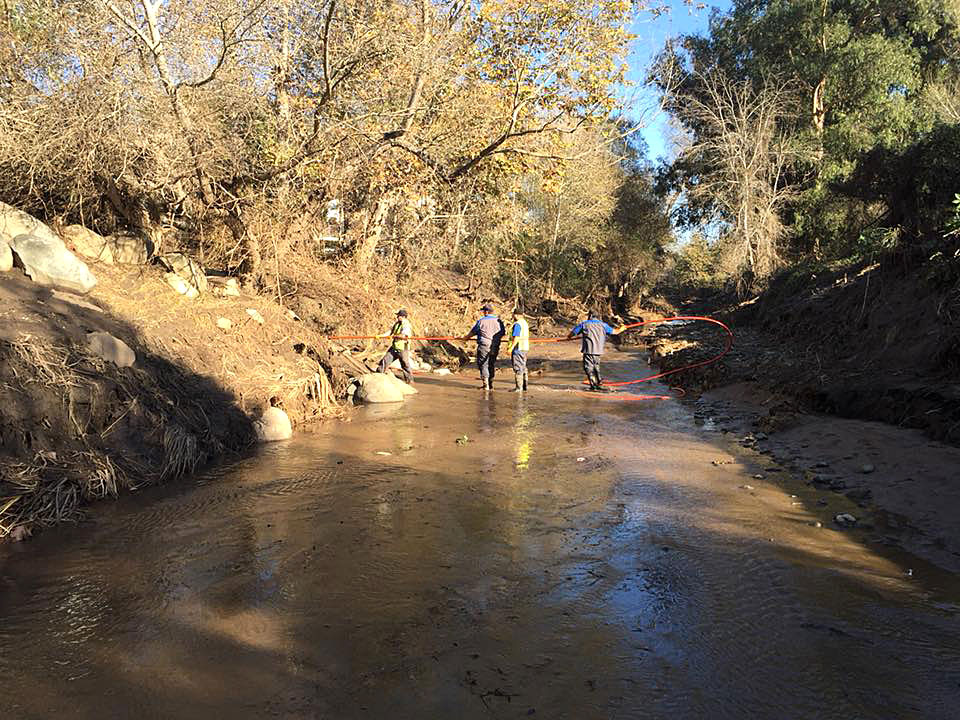
Carpinteria sewer crew helping with clean-up in January 2018. By Mark Bennett
Anything else you learned?
Community and teamwork. I re-learned what those words really mean.
I was reminded what it is to be part of a great team and live in a community as special as Carpinteria. We have all been through a lot with the Thomas Fire. Leading up to the debris flow our staff had all undergone tremendous stress in both their personal and professional lives.
We all had to balance our jobs, manage our families through multiple evacuations, road closures, unbreathable air, assisting with brush clearing and helping others in need at the drop of a hat.
By the time the debris flow occurred, we were all in a steady state of planning, prepping and reacting to anything that needed to be done to keep our families safe and to ensure our infrastructure at the District remained operational.
This paid dividends in our ability to assist others in Carpinteria and Montecito that were in need of assistance. I am proud of all them and thankful for their efforts at work and in the community.
Thinking back as a water professional, what stands out for you most from that Montecito and Carpinteria area mudflow?
Looking at it from Montecito’s perspective sometimes you can be totally prepared and there’s nothing you can do. When it wipes out everything you just have to deal with it and react.
I’ve listened to old timers and they told me stories about water coming over the creek and flooding certain areas of Carpinteria. It’s hard to believe because you’ve lived here for so long and you haven’t seen that, but you’ve heard about it.
Listening to the old timers tell stories is helpful. You always just keep that in the back of your mind. When we do these exercises for contingency planning and disaster planning, have some “what ifs” put out there.
So it’s a trained response rather than a knee jerk reaction.
These things have happened before. We’ve had flooding after fires. I’ve been here my whole life and it seems like every year there’s a fire.
Everything’s related to the name of that fire. The Coyote fire, Romero Canyon fire, Sycamore Canyon fire, then you go to the modern fires, the Jesusita and the Painted Cave fire.
These fires have always happened, and you learn from those and you make sure your staff is aware of what has happened before. It just seems like they continue to happen and after the fires come the floods, it’s inevitable.
It’s the new normal. It’s not going to be a onetime thing, it’s going be continual every time there’s rain.
Prepare for the worst and hope for the best.
We’re hoping everyone stays safe out there during this winter’s storms.
If you have tips or tricks for handling storm flows at your agency, leave them in the comments below or email story ideas at [email protected].